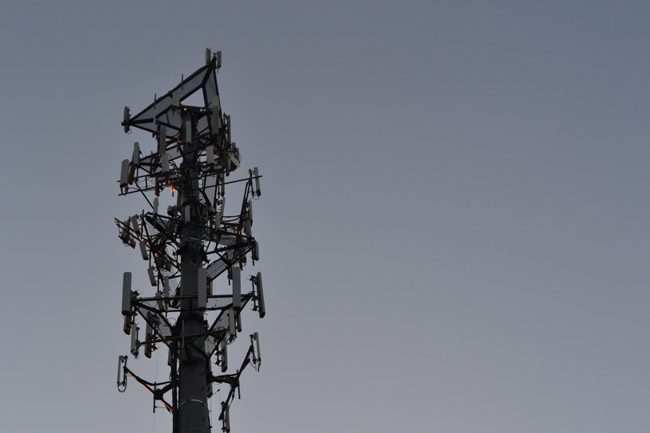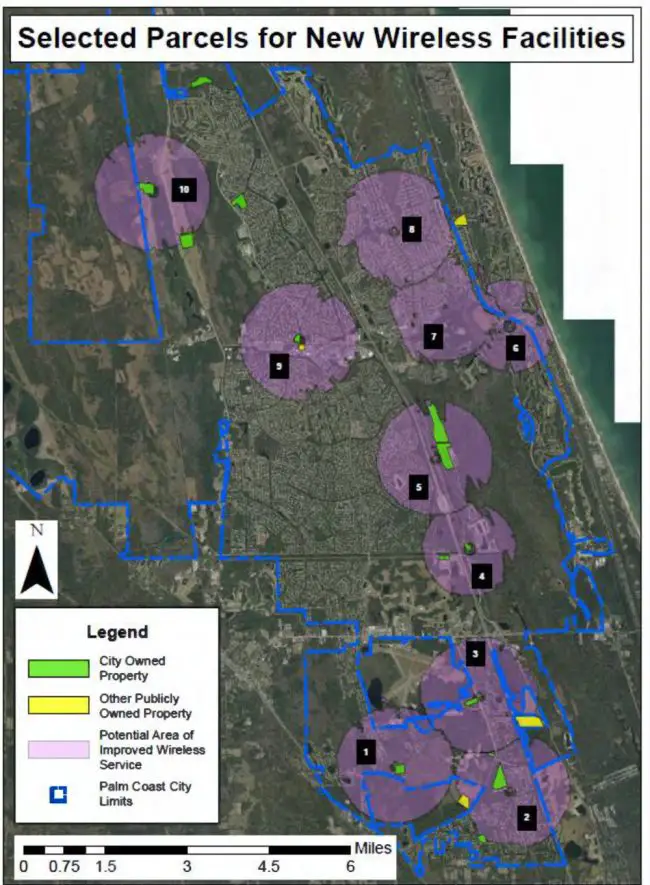
The Palm Coast City Council on Tuesday unanimously adopted a full re-write of its wireless rules, opening more than two dozen sites in the city to potential 150-foot cell towers, including in or near residential areas, and giving the city administration, as opposed to the council, broad leeway in determining where towers go, how many may rise and what they may look like.
The change is the first comprehensive rewrite of Palm Coast’s wireless ordinance and its parallel rules in the Land Development Code since 2005, a pre-historic time in wireless years: the iPhone was still two years from being introduced, YouTube had just been born, and wireless data was a fraction of what it is today, when less than half of all households in Florida are connected to landlines anymore. Palm Coast’s outdated rules have hurt cell coverage and given the city a bad reputation among carriers.
The city hopes that the new rules will create big incentives for wireless carriers to come to Palm Coast and improve what has been poor to dismal wireless service in many parts of the city.
“Palm Coast is maybe a little bit behind some of the other communities related to coverage, so the plan is,” Randy Kilgore, a carrier recruiter with Diamond Communications, “to approach the carriers and really show that Palm Coast is serious about improving coverage, and we want to set Palm Coast apart from other jurisdictions and show that willingness to improve service, potentially add new infrastructure on city properties with a sort of a fast-track approval process ultimately to get more sites in the city to help the residents, businesses and visitors to have a better experience.”
A hope for better coverage at the cost of lesser aesthetics and fewer controls.
The City Council hired Diamond last spring to develop a wireless plan and manage the city’s relationships with future carriers. In exchange, Diamond gets to build towers on city or public sites for just a one-time $25,000 fee to the city, and to keep 60 percent of the revenue generated from carriers at those sites, with the city getting 40 percent of the revenue. The city owns four existing cell-ready sites. In those cases, Diamond would get a cut from existing contracts as well, taking 25 to 35 percent of revenue. The city does not pay anything for construction of new sites. The contract was controversial. Its terms were generous to the company, its outcome uncertain, and the city’s commitment to Diamond, for a potential 20 years, locked in the city with a communications company at a time when the industry is defined by change, not stability. Diamond won the contract in a 3-2 vote.
Stephanie Capehart, one of just three Palm Coast residents who addressed the council on the issue Tuesday evening, objected to Diamond on the same grounds, but Landon said “you have to have the technical people to work with the carriers,” and blamed the absence of that expertise for the city getting “stagnant” on the matter.
The council is now committed to making things work with Diamond, assuming things go according to the plan Diamond prepared.
Last week and this week Diamond submitted its plan, which was contingent on the city adopting a series of steps that could make the plan a reality. But the plan improves incentives for carriers to come to Palm Coast. It does not guarantee it. It will take several years to take shape. And key questions are unanswered.
“This master plan like any other is probably five years out,” City Manager Jim Landon said, though he said it would not be a “stagnant process.” That’s why so many potential sites were put on the table as possible tower sites: 25 are owned by the city, three by the school board, ranging from 1 acre to 83. (See the list and maps in the embedded document below, in the appendix to the master plan.)
How much the carriers would be willing to pay—or not pay—to rent space on existing or new towers is not clear. Landon is willing to offer incentives. But that may not be his call. “First three years could be free as far as we’re concerned, trying to provide that incentive, then after that we would go market rate,” Landon said of what carriers would be charged. “I don’t know if that’s practical, or if that’s what Diamond is thinking, but right now we’re trying to encourage them to come.”
The contract with Diamond doesn’t give the city a say as to how much a carrier may be charged, let alone whether the city can forgive a carrier’s fees for three years—money that would be taken out of Diamond’s own incentive to build towers or recruit carriers. It would essentially be asking Diamond to work for free for those three years. That’s not likely. Its three officials who presented the plan to the council Tuesday remained silent when Landon floated the idea, a silence that may have spoken loudly enough.
What they did say should give residents who have long complained about poor service some hope.
“Coverage is the main objective and coverage is really the area of most opportunity for wireless development,” Diamond’s Dan Turnpot said. “There are probably some areas in Palm Coast where there is coverage but there isn’t enough capacity, and those might be areas along Palm Coast Parkway, for example, where small cells might have a role in the more near-term future, but for now we really think that macro sites are needed to provide kind of that blanket coverage that’s still kind of lacking in a lot of areas in Palm Coast.” (A macro cell can cover a radius of from less than a mile to five miles, and can have the same reach as a dozen small cells.)

Diamond determined that 10 specific areas needed improvement, and came up with 80 possible sites to address coverage, whittling those down to the 28 or so that the council approved as potential tower sites. It did so with the administration, which stepped in to eliminate one site that was deemed too close to homes. The rule will be that towers may rise 150 feet, but must have 150-foot buffers, or setbacks, from the nearest private property. Monopoles will be favored. New latticed structures such as the towers on U.S. 1 will be prohibited. But the monopoles are not likely to be dissimulated or masked by shrubbery, as that reduces effectiveness. Aesthetics will suffer, but coverage should improve.
The new ordinance also specifies: “Freestanding monopoles are prohibited from single-family or multi-family residential districts unless the applicant can conclusively demonstrate to the satisfaction of the City that it cannot reasonably provide its service to the residential zone from outside of the district. The City shall cooperate to determine an appropriate location for the freestanding tower of an appropriate design within the residential district.”
That’s a 180-degree change from current practice, which forbids towers in residential districts. But that’s also the tradeoff: residents who have been complaining for years must make room for some compromises if they expect to see improvements. So does the city.
Landon conceded that the city’s reputation has hurt it in attracting carriers, who consider Palm Coast a difficult place to do business. (That reputation was built over the 10 years of Landon’s own tenure as manager, a tenure not known for its accommodations of business). The master plan is intended to change that reputation. “What we’re trying to do here,” Landon said, “is make it easy but also with the marketing and keeping in touch with them, trying to change that image and let them know that yes, we’ll build towers—they don’t build towers, they put antennas on towers—we’ll build towers where they need to be, or we have towers that they can add to.”
The arrangement with Diamond is designed to keep the city in control of its wireless infrastructure’s “development,” a key distinction that leaves the bulk of that potential infrastructure itself in Diamond’s hands. In other words, the city has final say as to where towers go, and the city council itself, while its role is severely restricted, will have final say on approving or denying any tower leases. But Diamond will build and run the towers, and of course cash in. Its success, being defined so closely with the city’s success in landing new carriers, means that to ensure that new carriers do move in, Diamond will have to be given a wide berth.
Curiously, the council voted on an ordinance that contained the affirmation of a vote that had not yet happened: that the city’s planning board had voted in favor of the proposed regulations. The council voted with that language in the ordinance on Tuesday. The planning board wasn’t meeting until tonight.
![]()
The New Ordinances and the Wireless Master Plan
Click to access palm-coast-wireless-masterplan-ordinances.pdf





























Tired says
That map sure is missing A LOT of yellow (other publicly owned land). Makes me wonder what else is missing?
Dave says
Now they want to erect CANCER TOWERS in residential neighborhoods so more people can play on there phones while watching tv while the baby cries smh
Anonymous says
Gee, a 60/40 split? Do we have another “red light camera” -like company situation here where Palm Coast gets screwed in revenue?
PcFC says
To say we need more coverage in the area is a definite. My concerns would be in length of time and the deal that Diamond is offering. I am sure as business leaders in Palm Coast your meeting with more than Diamond. Can you provide a pros and cons of at least three companies bidding to get this, length of time and their terms. Does the citizens who do and dont have good coverage get a say in this, as to who they see as the best wireless contractor for this. Diamond seemed a little to take it or not ,he could care less attitude from this article, and another 6 years plus profits from existing , i believe he would get a No vote if i was voting or at least we will review options and be in touch.
Stretchem says
In the meanwhile, the rest of civilization outside of Flagler County will be buzzing along with thousands of low earth orbit satellites coupled with land based 5G nodes eminating from every household. In just a couple of years cellular will be all but obsolete, going by way of the horse and buggy.
Palm Coast will have what will be considered rediculous looking bird parking structures, and Landon will be fat and happy with his kickbacks.
woody says
Sounds like a great deal for Diamond.People now can concentrate on greater cellphone reception and less on that pesky driving.
cell phone user says
if it improves rates, coverage and overall wireless capabilities then I say go for it. if not, then don’t. I understand health risk and I understand property concern but really… we’re not building nuclear reactors.
Brian Roach says
Looks like Palm Coast politicos have their act together way better than the clowns who are running St. Augustine Beach in regard to the necessity of increased cell tower coverage. I think they have some Trumpian view of towers being NIMBY eyesores that detract from the “desirability” of the utopian life in SAB. Ask any tourist, business owner or working resident and they’ll tell you how frustrating it is to have to walk out to the middle of the street or leave the beach to get reception.
Realist says
Seems like it is difficult to see where they will put the towers. Lets get addresses. Anything Landon id for, I would be skeptical about.